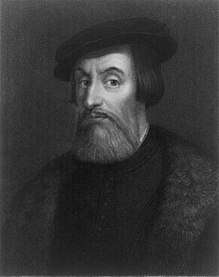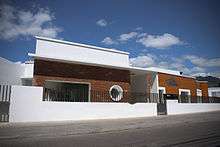Spanish migration to Honduras
Honduras has a large Spanish community, distributed throughout the country. According to the National Institute of Statistics of Spain, 2,888 Spanish citizens live in Honduras as of 2017.[1]

.svg.png)
History
The first Spanish citizen in Honduras was the conquistador Gil González Dávila, who arrived in March 1524. He founded the villa of San Gil de Buena Vista. From there, he forged his way deeper inland, attempting to pacify the indigenous population while simultaneously fighting against other Spaniards who contested his territory. He also hoped to find the outflow of Lake Nicaragua.[2][3]

Later, Hernán Cortés, motivated by reports of the great wealth of the region, sent two expeditions; one by land and another by sea. The first expedition was led by Pedro of Alvarado and the second by Cristóbal of Olid. After being betrayed by Cristóbal of Olid[2], Cortés decided to leave Mexico and take matters into his own hands, commanding an expedition that lasted nearly two years and ended in Trujillo, after surviving many dangers and hardships.[4]
Cortés introduced cattle farming to the area, and founded the villa of the Nativity of Our Lady, near Puerto Caballos. Before his return to Mexico in 1526, he installed Hernando of Saavedra as governor of Honduras, and left instructions to treat the indigenous population well.
On 26 October 1526, Diego López of Salcedo was appointed governor of Honduras by the emperor, replacing Saavedra. The following decade was shaped by the personal ambitions of governors and conquistadors, which often came into conflict with the interests of governmental organisation. The colonial Spanish rebelled against their leaders, and the indigenous population rebelled against the Spanish landowners and their abuses.[2][5]
Creole people were the most determined to obtain independence for Honduras. Paralleling what occurred in the Captaincy General of Guatemala, Honduras-born descendants of Spaniards began a movement to make the country independent, both from the Kingdom of Spain and from the Viceroyalty of New Spain. Liberal reforms were initiated to give them more local control over the economy and education.[6]
In the first years of Honduran independence, towards the end of the era of free trade between Latin America and Spain, a large proportion of the Spanish people arriving in Honduras were Catalans.[7]
Honduras was a country that received immigrants from diverse regions of the world. Spanish settlers typically came to start businesses in rural areas, cultivating crops such as coffee, bananas and sugar, which were exported to Spain and other European countries. Such foreign investment in Honduras was a first step towards developing a more robust economy, through the exploitation of natural resources and the generation of wealth and employment, however conflict arose when indigenous chiefdoms seized farms and ranches.[8]
With the acceptance of treaties for the recognition of titles, at the end of the 19th century and beginning of the 20th, through the initiative of president Luís Bográn, the Doctor Antonio Abad Ramírez y Fernández Fontecha (Cádiz, 1855), Honorary Consul of Spain in Tegucigalpa and Rector of the Central University of the Republic of Honduras, President of the Scientific-Literary Academy and President of the Supreme Council of Public Instruction, organised "cultural missions" with the objective of hiring artists and teachers from Spain through orderly immigration.[9][10]
Spanish immigration to Honduras is protected by the Hispanic-Honduran Agreement for Social Cooperation, which affirms—among other things—"The principle of equality and reciprocity in labour matters, so that Spaniards and Hondurans who work overseas in Honduras or Spain, respectively, enjoy the same labour rights as citizens, after having been accredited by the appropriate labour organizations", and which established the basis for the current cooperation between Spain and Honduras to further economic development.[11] This principle is consistent with the Treaty of Peace and Friendship, whose fifth article establishes that "the nationals of either of the two States will enjoy in the other those privileges have been granted or are granted to the citizens of the most favoured Nation, with the exception of those from Central America".
In 1996 the Treaty of Double Nationality between the Spanish State and the Republic of Honduras took effect, which makes citizenship of the two countries compatible.[12] The Historical Memory Law of Spain has also allowed a large number of Hondurans of Spanish origin to recover their Spanish citizenship.[13]
Spanish culture in Honduras
.jpg)
The Spanish language is Spain's greatest contribution to Honduran culture, and continues to be the main cultural bond between the two countries.
Holy week is part of the Spanish inheritance of the Hondurans, a religious and secular festival that has been celebrated since colonial times.[14]
In the 1950s, Spaniards living in Honduras, and Hondurans who had previously studied in Spain, created the Honduran Institute of Hispanic Culture.
The Spanish community has participated actively for decades in the Festival Folclórico Internacional (International Folklore Festival) in San Pedro Sula.
Honduras established the Cultural Centre of Spain in Tegucigalpa in 2007.

Spanish communities
The city with the largest Spanish population in the country is San Pedro Sula, which is where European, American, and Latin American companies usually begin their investment and industrial projects.
- Associació Catalan d'Hondures, San Pedro Sula[15]
- Spanish Society of San Pedro Sula
- Although it was active for many years, the House of Spain in Tegucigalpa, is not currently operating.
- Spanish Society of Welfare and Culture of Atlántida.
- Territorial Section of Working Commissions in Honduras.
After the creation of the Councils of Residents in Guatemala and Nicaragua, Honduras is one of the last countries of the region without its own Council.
During the reconstruction work after Hurricane Mitch, a network of associations of Spaniards, NGOs, and branches of the Spanish embassy organised national-level distribution for Spain's emergency assistance.
Spanish diplomatic relations in Honduras
The Spanish embassy in Honduras not only takes responsibility for protecting Spanish citizens who reside in the country temporarily or permanently; through various civil organisations, it has also supported programs to combat poverty and malnutrition in Honduran children, as well as projects to preserve cultural heritage.[16]
- Embassy of Spain in Tegucigalpa.

- Honorary Consulate in San Pedro Sula.
- Technical Office of Cooperation
- Economic and Commercial Office.
- Cultural Centre of Spain
- Office of Projects of the Andalusian Agency for International Development Cooperation.
- Spanish Official Chamber of Commerce in Honduras.
- The Spanish Agency for International Development Cooperation also has Regional Offices of Projects in Santa Rosa of Copán, The Ceiba and Saint Lorenzo.
Growth of the Spanish population in Honduras
| Year | Spanish Population |
|---|---|
| 1877 | 77 |
| 1910 | 196 |
| 1926 | 464 |
| 1930 | 643 |
| 1935 | 726 |
| 1945 | 589 |
In 2013, the official census of foreign nationalized Hondurans was 29,000 people, of whom 23,577 were from countries in the American continent, 2,939 from countries in Europe, 56 from countries in Africa, 19 from countries in Oceania, and 2,603 from Asia, of whom 1,415 are Chinese.
See also
References
- "Estadística del Padrón de Españoles Residentes en el Extranjero. Datos a 1-1-2017". Instituto Nacioanl de Estadistica. Retrieved 30 August 2017.
- Vera, Robustiano (1899). "Apuntes para la Historia de Honduras". Missing or empty
|url=(help) - Cindy Kilgore & Alan Moore (27 May 2014). Adventure Guide to Copan & Western Honduras. Hunter. ISBN 9781588439222. Retrieved 29 January 2011.
Spanish conquistadores did not become interested in colonization of Honduras until the 1520s when Cristobal de Olid the first European colony in Triunfo de la Cruz in 1524. A previous expedition was headed by Gil Gonzalez Davila
- Jalhay, Henry (1899). Monthly Bulletin Bureau of The American Republics Washington D.C. Retrieved 19 January 2011.
- Pascal Girot (1994). The Americas. Greenwood Press. pp. 284–285. ISBN 0-415-08836-4. Retrieved 27 January 2011.
- The liberal reform Archived 21 May 2016 at the Wayback Machine
- Spanish emigration to Latin America
- Spanish immigration
- The Diplomatic Representation of Spain was not elevated to the rank of Embassy until 1951
- Spanish emigration to Honduras
- 20 years of the signature of the Hispanic Agreement-Honduran of social cooperation
- Update of the Agreement of Double Nationality between the Realm of Spain and the Republic of Honduras
- 102.050 registrations of Spaniards thanks to the Historical Memory Law
- "Archived copy". Archived from the original on 15 August 2016. Retrieved 18 July 2016.CS1 maint: archived copy as title (link)
- Associació Catalan d'Hondures
- Embassy of Spain in Honduras
- Source: El capitalismo de San Pedro Sula y la historia política hondureña 1870-1972, Euraque, Dario A. (Archivos DGE-Honduras) page 76.